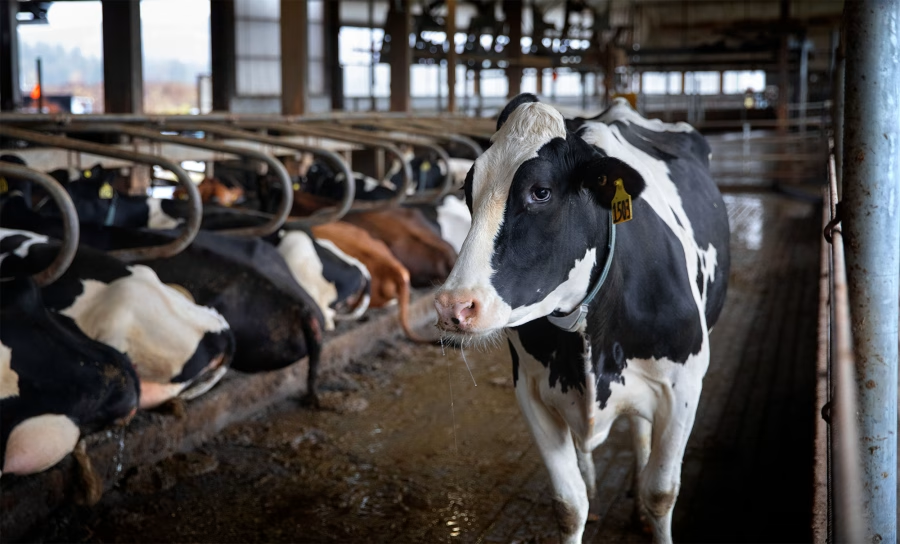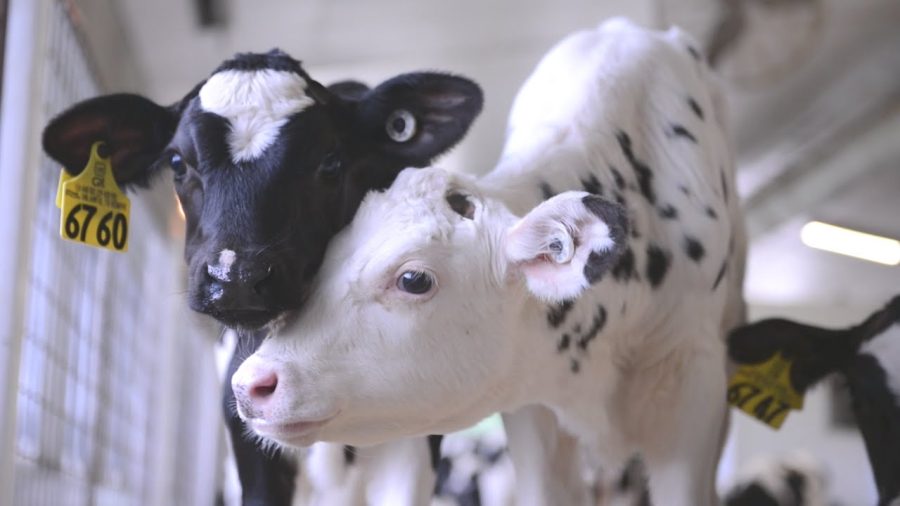Maximize dairy farm profits by preventing fertility issues and pregnancy losses in multiparous cows. Are you ensuring optimal reproductive management for your herd?

Profitable dairy production depends on maintaining a significant proportion of multiparous cows in your herd. To clarify, multiparous cows are those that have given birth to more than one calf. These cows are more economically advantageous and prolific than primiparous cows, which are those that have given birth only once. Managing the fertility of multiparous cows and avoiding pregnancy losses is therefore crucial. By ensuring at least 70% of your herd are multiparous cows, you can significantly improve milk productivity and financial returns.
Failure to prioritize pregnancy control and fertility management can result in unnecessary slaughter, which can significantly lower the genetic potential and overall output of your herd. As reproductive technologies continue to advance, it becomes increasingly urgent for you to adopt strategies that enhance your cows’ reproductive efficiency. By implementing efficient fertility programs and early interventions, you can significantly reduce these losses and ensure the long-term success of your dairy farm.
The High Stakes of Managing Multiparous Cows: Fertility and Economic Implications
| Economic Impact Area | Cost Impact |
|---|---|
| Increased Culling | $100 – $200 per cow |
| Lost Milk Production | $300 – $400 per cow |
| Extended Calving Interval | $50 – $100 per day |
| Increased Veterinary Costs | $20 – $50 per cow |
| Replacement Heifer Rearing Costs | $1,200 – $1,500 per heifer |
Low fertility and pregnancy losses may significantly impact dairy farm profitability and productivity. Because of reproductive issues, significant financial losses might arise from the killing of multiparous cows—those with more than one calf. These cows are very expensive, so early removal disturbs the output of the herd.
Generally speaking, multiparous cows give more milk than younger cows or heifers. Early culling of these productive animals might lower general milk output, affecting profitability. Changing them with younger, less productive animals compounds this loss as heifers need time and money to raise.
Along with opportunity losses from their reduced productive lifetime, the direct expenses of culling include costs for feed, veterinary care, and administration of the culled cows. These direct losses can be substantial, especially when considering the high cost of maintaining a dairy cow. Furthermore, introducing younger cows into the herd adds further financial pressure, which calls for careful management and investment in reproductive programs.
Managing fertility and reducing pregnancy losses is essential to keeping a healthy herd and hence saving the costs related to early culling. Best practices, including scheduled A.I. procedures, regular pregnancy detection, and modern reproductive technology, may assist in maintaining the percentage of multiparous cows, hence promoting long-term profitability and productivity.
Revolutionizing Reproduction: The Impact of Advanced A.I. Protocols in Dairy Farming
| Protocol | Pregnancy Rate (%) | Additional Benefits |
|---|---|---|
| Double Ovsynch | 45% | High synchronization, reduced embryonic loss |
| G6G | 42% | Improved first service conception rates |
| G7G | 39% | Enhanced follicular development |
| Presynch-11/Ovsynch | 40% | Better timing for ovulation, reduced interval between AI services |
While advanced reproductive technologies offer remarkable potential, they also come with challenges that must be navigated. Detecting pregnancy early and incorporating a blend of automated activity monitoring with these synchronization protocols can drastically improve fertility outcomes. By aiming for at least 70% of the herd being multiparous, dairy producers can ensure sustainable productivity and profitability.
Advances in reproductive technology over recent years have transformed dairy herd fertility and pregnancy control. For instance, Double Ovsynch, Presynch-11/Ovsynch, G6G, and G7G are advanced reproductive technologies that synchronize ovulation, guaranteeing ideal timing for A.I. These technologies have been proven to significantly increase fertility rates and improve the chances of successful conception, thereby enhancing the overall productivity and profitability of dairy farms.
These technologies mainly help to raise fertility rates. Data indicates that compared to estrus identification with automated activity monitoring, multiparous cows treated with Double Ovsynch had a 260% increased likelihood of conception. This proactive technique reduces calving intervals, therefore improving farm profitability and output.
Early, precise pregnancy diagnosis by ultrasound scanning and pregnancy-associated glycoproteins (PAGs) also enables prompt re-inseminations and pregnancy loss identification. Maintaining many multiparous cows—essential for continuous milk output and economic stability—depends on early identification.
Still, these technologies need careful planning and supervision, which may be time-consuming. While providing genetic advances, techniques including sexed semen or in-vitro produced (IVP) embryos are dangerous for multiparous cows because of lower pregnancy rates and more losses.
Despite the challenges, advanced reproductive technology holds immense potential for the dairy farming industry. By enhancing breeding plans and reproductive control, dairy farmers can substantially increase profitability and efficiency, thereby ensuring long-term sustainability and success for their farms.
Maximizing Reproductive Success: The Imperative of Timed A.I. Before 85 Days in Milk
Successful pregnancies depend on ensuring multiparous cows have timely A.I. before 85 days in milk. Double Ovsynch, G6G, G7G, or Presynch-11/Ovsynch simplify reproductive efforts by lowering the time between calvings, which is the period from one birth to the next, and improving herd efficiency. These systems coordinate estrus cycles, maximizing the breeding window for conception and increasing pregnancy rates. Giving scheduled A.I. top priority helps multiparous cows retain their reproductive capacity, increasing farm profitability and output.
Harnessing Technology: The Synergy of Automated Activity Monitoring and Timed A.I. for Optimal Reproductive Management
Modern dairy herd management depends heavily on automated activity monitoring devices, particularly for estrus detection in non-pregnant cows. These sophisticated instruments use pedometers, accelerometers, and sensors to track cow movement and behavior in real time. Tracking activity variations helps them precisely detect estrus, which is necessary for timely artificial insemination (A.I.).
Automated monitoring-based estrus detection has many main advantages. It guarantees timely insemination at maximum fertility, therefore increasing conception rates. It also lessens manual observation so agricultural employees can concentrate on more essential management tasks.
Automated activity monitoring improves timed A.I. systems such as Double Ovsynch or G6G when combined. TimedTimed A.I. synchronizes ovulation for optimum inside, the accuracy of breeding plans, and increased reproductive success.
Timed A.I. automated activity monitoring helps to provide complete management. Monitoring helps early, allowing for reduced cycle restoration between prompt and non-pregnant cows by means of further terminus confirmation action. More research improves synergy multip, boosting cows’ economic viability and herd production.
Preserving Herd Fertility: The Critical Role of Early and Recurrent Pregnancy Detection in Dairy Management
Dairy herd management depends heavily on early and frequent pregnancy identification. Frequent tests identify pregnancy losses early, enabling quick interventions and changes in reproductive plans. This guarantees the retention of pregnant multiparous cows and the early identification of possible replacements. Early inspections and twice-weekly rechecks before 120 days post-A.I. allow farmers to get important information on the reproductive health of their herd, therefore improving fertility control and general output.
Strategic Utilization of Sexed Semen and IVP Embryos: Enhancing Genetic Gains While Safeguarding Multiparous Cow Productivity
Particularly in heifers and first-lactation cows, sexed semen and IVP (in vitro produced) embryos provide exciting means for genetic improvement. With their excellent reproductive rates, these younger cows are perfect candidates for these technologies. Their robust reproductive health produces more significant results than older, multipurpose cows.
Multiparous cows face more difficulties. Their reproductive effectiveness usually suffers with many pregnancies and lactations. Stress from past calvings and ongoing milk output may lower reproductive rates. Using sexed semen or IVP embryos in these cows usually leads to reduced pregnancy rates and more pregnancy losses. This compromises initiatives aimed at preserving a high percentage of multiparous cows in the herd.
Economically, the hazards are substantial. Early embryonic losses or failed pregnancies call for more insemination efforts, more expenses, and longer gaps between pregnancies. This affects profitability and herd capacity. Although sexed semen and IVP embryos help younger cows, their usage in multiparous cows should be carefully considered to prevent these hazards. Optimizing results over many cow stages and paries depends on efficient reproductive control, which is the process of managing and monitoring the reproductive health of the herd, using customized methods.
The Bottom Line
Improving pregnancy rates requires synchronizing primiparous cows with sexed semen using fertility programs such as Double Ovsynch or G6G. These algorithms address the reduced conception rates of sexed semen by matching artificial intelligence with cows’ cycles. Double Ovsynch pre-synchronizes the estrous cycle to match scheduled A.I., improving fertility results and raising the likelihood of a successful pregnancy.
In a similar vein, the G6G method precisely synchronizes ovulation using hormonal therapies. This preparation helps the reproductive system react better to A.I., therefore lowering the hazards connected with sexed semen. These fertility initiatives guarantee that primiparous cows are reproductively ready, thus increasing pregnancy rates and improving the herd’s long-term output through genetic enhancement.
Start now by including these cutting-edge reproductive treatments in your herd management schedule. Maximizing reproductive efficiency helps you protect the output of your multipurpose cows and improve the genetic basis of your whole herd. Start today making wise breeding choices for a more lucrative and sustainable dairy farming future.
Key Takeways:
Effective fertility management and minimizing pregnancy losses in multiparous cows are vital for maintaining a profitable and productive dairy herd. Here are the key takeaways to ensure you keep the proportion of multiparous cows high:
- Unnecessary culling of multiparous cows can severely impact dairy farm profitability and production.
- A general aim is to have 70% or more of the herd as multiparous cows at any given time.
- Implementing advanced reproductive technologies and understanding their benefits and challenges is essential for enhancing efficiency and profitability.
- Adopt timed A.I. protocols like Double Ovsynch, G6G, G7G, or Presynch-11/Ovsynch, which significantly improve the chances of pregnancy in multiparous cows.
- Ensure timed first A.I. is administered before 85 days in milk to control fertility effectively.
- Utilize automatic activity monitoring to track estrus in non-pregnant cows, enhancing pregnancy detection and response times.
- Detect pregnancies early and recheck frequently, up to 120 days post-A.I., to identify losses and manage replacements proactively.
- Use sexed semen or IVP embryos selectively, primarily for heifers and first-lactation cows, to balance genetic gains with the risk of reduced pregnancy rates and losses in multiparous cows.
Summary:
Profitable dairy production relies on maintaining a significant proportion of multiparous cows, which are more economically advantageous and prolific than primiparous cows. Managing the fertility of multiparous cows and avoiding pregnancy losses is crucial, as ensuring at least 70% of the herd is multiparous can improve milk productivity and financial returns. Failure to prioritize pregnancy control and fertility management can result in unnecessary slaughter, lower genetic potential, and lower overall output. As reproductive technologies advance, it is urgent for dairy farmers to adopt strategies that enhance their cows’ reproductive efficiency. Implementing efficient fertility programs and early interventions can reduce losses and ensure the long-term success of their dairy farm. Best practices, including scheduled AI procedures, regular pregnancy detection, and modern reproductive technology, can help maintain the percentage of multiparous cows and promote long-term profitability and productivity.
Learn more:
Understanding the intricate dynamics of managing fertility and pregnancy in multiparous cows is crucial for dairy producers looking to enhance productivity and profitability. For more insights on optimal reproductive strategies and the impacts on dairy farming, consider exploring the following resources:












